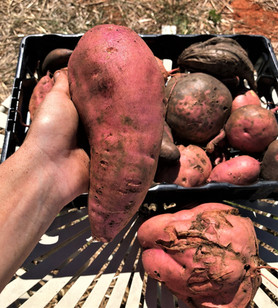September 9-25
- Rosa
- Sep 26, 2019
- 4 min read

Little Harvests
The borage and chamomile continue to mature, yielding tiny but beautiful harvests. I've noticed that the borage flowers tend to begin pink and become blue-er, and that once they are deep sky blue they separate more easily from their spiny sepals.
The birdhouse gourds are in a race against the white powder consuming their leaves. The baby fruit are teenagers now, big and green but still growing. New flowers continue to unfold, so perhaps the vines will leave a hearty legacy of gourds.
Chicks
The Rhode Island Reds have shed nearly all of their downy baby feathers and are now glossy rust-red. Still too young to merge with the adults, we make sure they are entertained in the run by bringing them branches and grasses and others things to explore.
I tore up some grapes and set them out on a leaf, to see if they wanted to eat fruit yet. In raising other chickens I've found that they become increasingly interested in treats with age. Some of our chickens took a full year to figure out how to eat fruits and vegetables. But Reds are a hearty breed, and our chicks are already practiced scratchers and bug-catchers. They took to the grapes at once, scooping one up and then dashing away, their sisters trailing behind. (All chickens share the same conviction that food tastes better stolen from someone's beak.)
Our adult flocks are settled into the patterns of life. They sprint towards us whenever we approach their fence, eager for dried bugs, seeds, melons, or veggie treats. Right now, many of the older hens are molting. The sight of a tail-less hen dashing across the yard never ceases to be amusing.
Hibiscus
A crop we have nurtured since spring is nearing harvest. Known as roselle, Hibiscus sabdariffa is used throughout the world for fiber, beverages, jam, and tea. Though the entire plant is useful, we are mainly interested in the sepals, or flower bud coverings. When dried, they can be steeped into brilliant, scarlet tea with a gentle, sour flavor.
Hibiscus plants (including this one and the showy tropical species), are members of the mallow family (Malvaceae). Okra is a mallow; the family resemblance is obvious if you break open a roselle fruit. Cocoa and cotton are also in the family, as well as the marsh-mallow, the plant once used to make what today are called marshmallows.
Sweet Bounty
We harvested our sweet potatoes. Digging food out of the ground is inevitably satisfying, but the sweet potatoes weren't nearly as easy to harvest as the spring potatoes. Pulling the plant up just lead to broken stems, so every potato had to be personally excavated. Many had grown under the mulch paths, or deep into the cement-hard clay. Still, they offered diversity as compensation for difficulty. Each new potato was an entirely new shape, and some of them weighed nearly three pounds.
In total we harvested maybe 50 pounds, probably more. We'll cure them for ten days and then store them. They have remarkably long shelf-lives on top of their remarkable health benefits. I've eaten them every day since harvest.
Peppers, okra, and the occasional tomato are still ripening. We also harvested most of our watermelons. The vines had died back, which usually indicates that the melon is ripe. Still, their sizes varied greatly, from hefty to minuscule. We shared a tiny one after the work of hauling them all in from the garden.
Since no one can stop me, I'm going to point out that sweet potatoes aren't closely related to normal potatoes. Sweet potatoes are in the morning glory family (Convolvulaceae) while potatoes are in the nightshade family (Solanaceae). Potatoes are related to tomatoes, tomatillos, eggplants, and peppers. I don't know what sweet potatoes are related to except morning glories, though that's not a shabby plant to have as family. Potatoes and sweet potatoes both serve as underground storage for their plants, which is what makes them superficially similar and genuinely good food.
Autumn in the Air
The plants know it's autumn now. Though it's remained fairly hot, the days are shortening and the summer plants are showing their final colors. The celosia blooms, utterly diverse in form, are all leaning earthward under their own weight. The Jerusalem artichokes are nearly done with their magnificent display. Now most of the yellow among their leaves is goldfinches, seeking seeds. Eventually, all the blooms will be gone from the garden. For now, the blush of summer remains.
Breaking Ground
With many of our plants done and the frost date approaching, we've been working double time on clearing the beds. The plants are pulled and the hay raked. Then it's edged, compost is added, it's shaped and churned, and everything is covered with a new blanket of hay. Into the revived beds, we'll plant seeds for our hardy annuals. They'll grow all winter, establishing roots which will allow them to bloom in early spring.
Golden Meadows
Autumn is painting the fields with its golden palette. Goldenrod blooms in swaths throughout the uncultivated parts of our land, alongside morning glories and white asters. My first memories of our land are these golden stands of flowers, and their honey-like smell. Now, they are blooming again, but this time I can see them from my window.

The past weeks we've transitioned to the new house. Now the Six Mile land is officially our home. After a season of commuting, it's exciting to live alongside our chickens and gardens, and to be so close as they continue to grow.
































































Comments